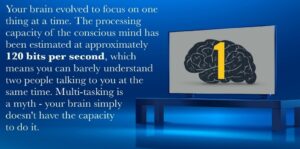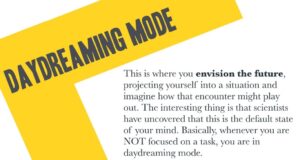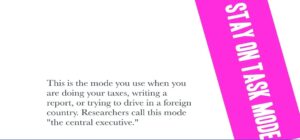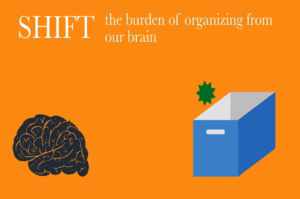The Organized Mind
by Daniel J Levitin – a Readitforme summary
“A place for everything, and everything in its place”
The Organized Mind by Daniel J Levitin – “A place for everything, and everything in its place”. It’s a principle that, for centuries, has allowed us to keep our physical world in order so that we can focus on whatever the task at hand is.
However, these days we have added the complexity of our digital and social worlds to the mix, making it harder and harder to keep things organized, and thus stay on track with the most important goals in our life.
The Current State of Information Overload
The Organized Mind states each day we are confronted with an unprecedented amount of information. Each of us processes about 100,000 words a day through all of the messages we are exposed to.
The average person watches 5 hours of television each day, which is the equivalent of processing 20 gigabytes of audio-visual images.
What does this have to do with your mind and how well it’s organized?
There are two things to consider here.
First, your brain evolved to focus on one thing at a time…

Second, this means that you need to make decisions…

This means that every status update you read on Facebook and every text message you get from a friend is competing for resources in your brain with more important things like how to finish that project that’s due by the end of the day.
Once you’ve exhausted the limit of your brain’s decision-making capacity for the day, you are unable to make good decisions, and ultimately you are unable to do great work.
-
How Attention Works
In order to understand how to have a well-organized mind, we need to know how our minds organize themselves.
There are four main components of the human attentional system, which is what drives who and what you pay attention to.
The first component is something we call daydreaming mode…

The second component is the “stay-on-task” mode…

While you are awake, you are in one of those two states, but never at the same time.
The third component is the attentional filter, which…

For instance, your brain doesn’t register all of the cars zipping by you on the other side of the highway
The fourth component of the attentional system is the attentional switch, allowing us to direct our attention to one thing, and then to another
Here’s a practical example to explain how this works in the real world. Let’s say you are reading a book, and you are “in the zone.” Then, all of a sudden, your phone buzzes – a change in your physical environment that your attentional filter lets through. At that moment, you decide that you want to see who just sent you a text and what it says, and you use your attentional switch to direct your attention from the book to the text message.
All of this happens so fast that we’re not aware that we are switching modes, nor are we conscious of making a decision. But that’s exactly what we do.
-
How Memory Works
The quick version of that is that we don’t remember things quite nearly as well as we think we do. And to make matters worse, we don’t always know when we are recalling things accurately or not.
This brings us to the ultimate conclusion that our memory sucks!
So what do we do about it? We find as many ways as we can to externalize our memories. This is an idea that goes all the way back to the Greeks, and its effectiveness has been confirmed over and over again by contemporary neuroscience.
There is evidence of this all around you. You don’t try and remember where you need to be at every moment of the day, you put your meetings in a calendar. You don’t try and remember all of the things you need to do, you make a to-do list. And so on. And this is where we start to discuss the strategies you can employ to create your very own Organized Mind.
-
Getting Part of Your Mind Outside Your Body
The most fundamental principle of the organized mind is to shift the burden of organizing from our brains to the external world

The world’s most successful people all employ systems that help them determine what to pay attention to and how to remember important things.
One of the most important reasons for this is so that they can remain focused on the most important tasks they have to complete.
In order to understand how they do that, we need to understand what happens if they don’t.
Your mind wandering mode does more than just think about the future. It is constantly scanning the environment for things that have remained undone. For instance, if you said that you would pick up some milk on the way home so your kids can have cereal tomorrow morning, your mind wandering mode will keep reminding you to do it. Which isn’t very helpful while you are in the middle of preparing for the biggest pitch in company history.
This consumes precious mental energy that you can’t afford to waste, because, as we’ve already covered, you have a finite amount of it every single day.
The simple solution to this problem is to write down every thought that intrudes on what you are doing. As long as you write it down somewhere you know you’ll find it when you need it, your mind wandering mode will chill out, leaving you to focus on the pitch.
3×5 notecard system
A surprisingly effective system for doing this is to use a 3×5 notecard system, with one item per card. You sort those cards into different categories, such as:
- things to do today

- stuff to do this week
- what can wait
- junk drawer
- shopping lists
- errands
- things to do at home
- things to do at work
- social
- things to ask Pat to do
- things related to Mom’s health care
- phone calls to make
This might sound like busywork, but the point is that getting things out of your mind and into some system that helps you get organized will ultimately free your mind to work on the most important things in your business and life.
Once your mind wandering mode knows that there’s a place for everything, and everything is in it’s place, it will let your “central executive” get back to work without interruption.
Now that we’ve covered how our minds work and the main principles of getting organized, let’s dive into some specific tactics and strategies you can use to be more productive.
Organizing Email
Most of you have your email programs set to put through arriving emails automatically or to check every few minutes. Basically, you have set up a scenario where you are systematically interrupted hundreds of times per day.
As we’ve already explored, this wreaks havoc on your attention, causing you to waste precious energy on task switching.
Instead, check email two or three times a day, at predetermined times. Even better, to keep your mind wandering mode at bay, schedule them in your calendar.
Organizing Stuff
No matter how efficient we become at organizing and externalizing our memories, sometimes we lose things. It’s best to create contingency plans for when we do.
For instance:

Organizing our social world
The more successful you become, the bigger your social circles become, and the more you’ll need to be able to keep your social life in order.
One strategy that most successful people use is to keep contact files with contextual information such as:
- where they met someone new;
- what they talked about;
- who introduced them.
Then, they will add tags or notes to help organize those entries into categories they can easily dive in and out of at a moments notice:
- work friends;
- school friends;
- childhood friends;
- best friends;
- acquaintances;
- friends of friends;
- etc.
Organizing our Time
Set aside time blocks of at least one hour at a time to do your most important work.
Also, spend 5 or 10 minutes before that session with a mind-clearing exercise. Write down everything that’s on your mind before that session so that you can devote your entire mind to the focused work that needs to get done.
Make sure to schedule breaks in your work as well. No matter how well you’ve cleared the decks for focused work, you’ll get tired and your mind wandering mode will start to sneak back in. This is a sign that it’s time to take a break.
The world’s most successful people work this way, and not only do they get more done, but they are also less tired and neurochemically depleted after doing it.
Get Your Sleep
You’ve heard this before, but it bears repeating – you need to get your sleep. It will allow you to bring better clarity and focus during your most important work. Your brain processes information in 3 different ways while you sleep.
First
There is unitization – the combining of discrete elements or chunks of an experience into a unified concept. For example, musicians and actors who are learning a new piece might practice one phrase at a time – sleep binds these together into a seamless whole.
Second
There is assimilation – the brain integrates new information into the existing network structure of other things you already know. In learning new words your brain works unconsciously to construct sample sentences with them, experimenting with how they fit into your pre-existing knowledge.
Finally
There is an abstraction – where hidden rules are discovered and then entered into memory. Sleep has been shown to enhance the formation and understanding of abstract relations. People often wake having solved a problem that was unsolvable the night before.
Conclusion…
There are many arguments for having a place for everything and keeping everything in its place.
The most important of which is that it will allow your mind – the most powerful tool you have at your disposal – to focus on the work that’s most important to your long-term success.
ActionCLASS happens every month, it is a book club where you don’t need to read the book to get the learnings!
- Learn the essence of the book in a dynamic format
- Share your learnings
- Create your action plan
- Give & receive feedback
- Commit to take action
- Enjoy the time you saved
Go to our EVENTS page or follow us on EVENTBRITE for details of the next class.
With thanks to our partners at:





